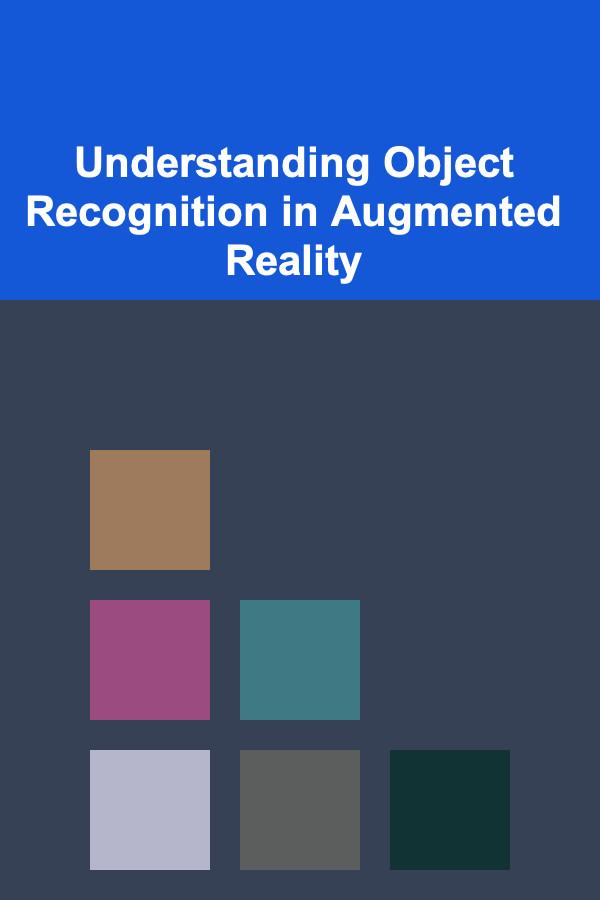
Understanding Object Recognition in Augmented Reality
ebook include PDF & Audio bundle (Micro Guide)
$12.99$5.99
Limited Time Offer! Order within the next:

Augmented Reality (AR) is rapidly transforming how we interact with the world, blending digital content with our physical surroundings. At the core of many AR applications lies the powerful technology of object recognition. This deep dive explores the intricate aspects of object recognition in AR, from its fundamental principles to the cutting-edge techniques that enable seamless integration of virtual elements into the real world. We will delve into the challenges, the enabling technologies, and the future directions of this critical component of the AR ecosystem.
What is Object Recognition in AR?
Object recognition in AR is the process of identifying and understanding objects in the real world through computer vision techniques. It's the capability that allows AR applications to understand what it's "seeing" through the device's camera and then use that understanding to anchor, augment, or interact with those objects. Essentially, it allows the digital world to react intelligently to the physical one. This goes far beyond simple image recognition, which might merely identify a photograph. Object recognition seeks to understand the attributes of the object: its shape, size, position, orientation, and even its semantic meaning.
Consider an AR application designed to help you assemble a piece of furniture. The app, using object recognition, can identify the different parts of the furniture, understand their relative positions, and then overlay instructions directly onto the physical pieces in real-time. This is a significant advancement over simply showing you a 2D diagram; it provides contextual and spatial awareness, making the assembly process far more intuitive and efficient.
Key Components of Object Recognition in AR
Object recognition in AR isn't a monolithic process. It's a carefully orchestrated sequence of steps, each relying on sophisticated algorithms and techniques. Here's a breakdown of the key components:
1. Image Acquisition and Preprocessing
The process begins with capturing an image or video stream from the device's camera. The quality of this initial data is crucial for the success of subsequent steps. Preprocessing involves cleaning up the raw data to improve its quality. This may include:
- Noise Reduction: Removing unwanted artifacts or distortions from the image using techniques like Gaussian blur or median filtering.
- Contrast Enhancement: Adjusting the image's contrast to improve visibility of features. Methods include histogram equalization and adaptive histogram equalization.
- Color Correction: Correcting for variations in lighting conditions to ensure consistent color representation across different images.
- Geometric Correction: Correcting for lens distortions that can warp the image.
Proper preprocessing significantly improves the accuracy and robustness of the object recognition process.
2. Feature Extraction
Once the image is preprocessed, the next step is to extract relevant features that can be used to distinguish objects. These features are characteristics or patterns in the image that are invariant to changes in viewpoint, lighting, or scale. Common feature extraction techniques include:
- Edge Detection: Identifying boundaries between objects or regions in the image using algorithms like Canny edge detection or Sobel operators. Edges are particularly useful because they are relatively insensitive to changes in lighting.
- Corner Detection: Locating points in the image where edges intersect or change direction abruptly using algorithms like Harris corner detection or Shi-Tomasi corner detection. Corners are robust features that can be used for matching and tracking.
- Scale-Invariant Feature Transform (SIFT): Detecting and describing local features that are invariant to scale and rotation. SIFT is a powerful algorithm but can be computationally expensive.
- Speeded Up Robust Features (SURF): A faster alternative to SIFT that uses integral images to speed up the feature detection and description process. SURF offers a good balance between accuracy and speed.
- Oriented FAST and Rotated BRIEF (ORB): A computationally efficient feature detector and descriptor that is well-suited for real-time applications. ORB is particularly popular in mobile AR applications.
- Histograms of Oriented Gradients (HOG): Describing objects based on the distribution of gradient orientations in local image regions. HOG is often used for object detection and pedestrian detection.
- Deep Learning-based Features: Using convolutional neural networks (CNNs) to learn features directly from the image data. CNNs can learn highly discriminative features that are well-suited for object recognition tasks.
The choice of feature extraction technique depends on the specific application and the characteristics of the objects being recognized. The goal is to extract features that are both distinctive and robust to variations in the environment.
3. Object Recognition and Classification
After extracting features, the system compares these features to a database of known objects. This is where the actual object recognition and classification take place. Several techniques are employed:
- Template Matching: Comparing the extracted features to a set of pre-defined templates. This is a simple but effective approach for recognizing objects with well-defined shapes and appearances.
- Machine Learning Classifiers: Training machine learning models to classify objects based on their features. Popular classifiers include:
- Support Vector Machines (SVMs): Effective in high-dimensional spaces and can handle non-linear data.
- Decision Trees: Easy to interpret and can handle both categorical and numerical data.
- Random Forests: An ensemble of decision trees that can improve accuracy and robustness.
- K-Nearest Neighbors (KNN): Classifies objects based on the majority class of its nearest neighbors.
- Deep Learning Models: Using convolutional neural networks (CNNs) to directly learn object categories from image data. CNNs have achieved state-of-the-art performance in object recognition tasks. Popular CNN architectures include:
- ResNet: Uses residual connections to train very deep networks.
- Inception: Uses parallel convolutional layers with different filter sizes.
- YOLO (You Only Look Once): A real-time object detection algorithm that can detect multiple objects in an image simultaneously.
- SSD (Single Shot Multibox Detector): Another real-time object detection algorithm that is known for its speed and accuracy.
- Mask R-CNN: An extension of Faster R-CNN that can also generate pixel-level object masks.
Deep learning models are generally preferred for their high accuracy and ability to learn complex patterns, but they require large datasets for training. Machine learning classifiers are often used when the dataset is smaller or when computational resources are limited.
4. Pose Estimation
In AR, it's not enough to simply recognize an object; the system also needs to determine its pose (position and orientation) in 3D space. This is crucial for accurately overlaying virtual content onto the real world. Pose estimation techniques include:
- Perspective-n-Point (PnP) Algorithms: Solving for the object's pose given a set of 3D points on the object and their corresponding 2D projections in the image. PnP algorithms are widely used in AR applications.
- Simultaneous Localization and Mapping (SLAM): Building a map of the environment while simultaneously estimating the pose of the camera. SLAM algorithms can be used to track the camera's movement and estimate the pose of objects in the scene. Visual SLAM (VSLAM) uses camera images as its primary input.
- Structure from Motion (SfM): Reconstructing the 3D structure of the scene from a series of 2D images. SfM can be used to create 3D models of objects and estimate their pose.
Accurate pose estimation is essential for creating a believable and immersive AR experience.
5. Tracking and Refinement
Once an object is recognized and its pose is estimated, the system needs to track the object's movement in real-time. This ensures that the virtual content remains aligned with the real-world object even as the user moves the device or the object itself moves. Tracking techniques include:
- Feature Tracking: Tracking the movement of specific features on the object across successive frames.
- Model-Based Tracking: Using a 3D model of the object to track its pose over time. This approach can handle significant occlusions and changes in viewpoint.
- Sensor Fusion: Combining data from multiple sensors, such as cameras, IMUs (inertial measurement units), and GPS, to improve tracking accuracy and robustness. IMUs provide information about the device's acceleration and rotation, while GPS provides location information.
- Filtering Techniques: Applying filtering techniques, such as Kalman filtering or particle filtering, to smooth the tracking results and reduce noise.
Even with advanced tracking techniques, errors can accumulate over time. Refinement techniques are used to correct these errors and maintain accurate alignment. This may involve re-detecting the object periodically or using optimization algorithms to minimize the difference between the predicted pose and the observed data.
Challenges in Object Recognition for AR
Despite the significant advancements in object recognition, several challenges remain, particularly in the context of AR applications:
1. Occlusion
Occlusion occurs when an object is partially or completely blocked from view. This can significantly degrade the performance of object recognition algorithms, as the system may not be able to extract enough features to accurately identify the object. Solutions include:
- Robust Feature Extraction: Using feature extraction techniques that are less sensitive to occlusion, such as those based on global shape descriptors.
- 3D Model-Based Tracking: Using a 3D model of the object to predict its appearance even when it's partially occluded.
- Contextual Reasoning: Using contextual information to infer the presence and location of the occluded object. For example, if the system recognizes a table and a chair, it can infer that the legs of the chair are likely behind the table, even if they are not visible.
2. Lighting Variations
Changes in lighting conditions can significantly affect the appearance of objects and make it difficult for object recognition algorithms to work reliably. Solutions include:
- Robust Feature Extraction: Using feature extraction techniques that are invariant to changes in lighting, such as those based on gradient orientations.
- Image Normalization: Normalizing the image to remove the effects of lighting variations.
- Adaptive Thresholding: Adjusting the threshold used for feature detection based on the current lighting conditions.
- Using HDR Cameras: Capturing images with a wide dynamic range to reduce the impact of overexposure and underexposure.
3. Viewpoint Variations
The appearance of an object can change dramatically depending on the viewpoint from which it is observed. Object recognition algorithms need to be robust to these viewpoint variations. Solutions include:
- Viewpoint Invariant Features: Using feature extraction techniques that are invariant to changes in viewpoint, such as SIFT or SURF.
- 3D Model-Based Recognition: Using a 3D model of the object to generate synthetic views from different viewpoints.
- Multiple View Training: Training the object recognition system on images of the object from a variety of viewpoints.
- Augmented Reality Cloud Services: Leveraging cloud services that can share 3D models and feature data across multiple users and devices, improving recognition accuracy from different angles.
4. Scale Variations
The size of an object in the image can vary depending on its distance from the camera. Object recognition algorithms need to be able to handle these scale variations. Solutions include:
- Scale-Invariant Feature Extraction: Using feature extraction techniques that are invariant to scale, such as SIFT or SURF.
- Image Pyramids: Creating a pyramid of images at different scales and searching for the object at each scale.
- Multi-Scale Detection: Training the object recognition system on images of the object at a variety of scales.
5. Real-time Performance
AR applications require real-time performance to provide a seamless and responsive user experience. Object recognition algorithms need to be fast and efficient enough to run on mobile devices with limited computational resources. Solutions include:
- Optimized Algorithms: Using optimized algorithms that are designed for mobile devices.
- Hardware Acceleration: Leveraging hardware acceleration features, such as GPUs, to speed up the object recognition process.
- Model Simplification: Simplifying the 3D models used for object recognition to reduce the computational load.
- Cloud Processing: Offloading some of the processing to the cloud to reduce the computational load on the mobile device. However, this introduces latency considerations.
6. Dynamic Environments
Real-world environments are constantly changing. Objects move, new objects appear, and lighting conditions fluctuate. Object recognition systems must be able to adapt to these dynamic environments. Solutions include:
- Adaptive Learning: Continuously updating the object recognition system based on new data.
- Contextual Awareness: Using contextual information to anticipate changes in the environment.
- Robust Tracking: Using robust tracking algorithms to maintain accurate object pose even in dynamic environments.
Enabling Technologies for Object Recognition in AR
The progress in object recognition for AR has been fueled by advancements in several key technologies:
1. Computer Vision
Computer vision provides the fundamental algorithms and techniques for analyzing images and videos. It's the bedrock upon which object recognition is built.
2. Machine Learning and Deep Learning
Machine learning and deep learning have revolutionized object recognition, enabling systems to learn complex patterns and achieve state-of-the-art performance. The development of CNNs has been particularly impactful.
3. Sensor Technology
Advanced sensors, such as high-resolution cameras, depth sensors (e.g., LiDAR, Time-of-Flight), and IMUs, provide rich data that can be used to improve the accuracy and robustness of object recognition systems.
4. Edge Computing
Edge computing allows processing to be performed closer to the data source, reducing latency and improving real-time performance. This is particularly important for AR applications that require immediate feedback.
5. Cloud Computing
Cloud computing provides access to vast amounts of computing power and storage, enabling the training of large deep learning models and the storage of large object databases. Cloud services also facilitate the sharing of 3D models and feature data across multiple users and devices.
Future Directions of Object Recognition in AR
Object recognition in AR is a rapidly evolving field with exciting future directions:
1. Semantic Understanding
Moving beyond simply recognizing objects to understanding their meaning and relationships within the scene. For example, understanding that a "chair" is used for "sitting" and is typically located near a "table."
2. Context-Aware Recognition
Leveraging contextual information, such as the location, time of day, and user activity, to improve the accuracy and relevance of object recognition.
3. Personalized AR Experiences
Tailoring the AR experience to the individual user based on their preferences and history. For example, showing different product recommendations to different users based on their past purchases.
4. Robustness to Adversarial Attacks
Developing object recognition systems that are resilient to adversarial attacks, which are carefully crafted inputs designed to fool the system. This is becoming increasingly important as AR applications are used in more critical applications.
5. Integration with AI Assistants
Integrating object recognition with AI assistants, such as Siri or Alexa, to enable users to interact with the real world using voice commands. Imagine being able to say, "Alexa, show me the instructions for assembling this bookshelf," and the AR system automatically recognizes the bookshelf and overlays the instructions onto it.
6. Continual Learning
Developing systems that can continuously learn and adapt to new objects and environments without requiring retraining from scratch. This is essential for creating AR applications that can operate in the real world, which is constantly changing.
7. Cross-Modal Object Recognition
Combining information from multiple modalities, such as vision, audio, and text, to improve object recognition accuracy. For example, using audio cues to identify an object that is partially occluded from view.
Conclusion
Object recognition is a fundamental building block of augmented reality, enabling seamless integration of virtual content into the real world. While significant progress has been made, several challenges remain, including occlusion, lighting variations, and the need for real-time performance. Advancements in computer vision, machine learning, sensor technology, and edge computing are driving innovation in this field, paving the way for more immersive, interactive, and useful AR experiences. The future of object recognition in AR is bright, with exciting possibilities on the horizon, from semantic understanding to personalized AR experiences. As the technology matures, we can expect to see AR applications become even more pervasive and transformative, changing the way we interact with the world around us.

How to Host a Backyard Picnic for Family Fun
Read More
How to Plan for Retirement: What You Need to Know
Read More
Innovate with Care: A Patent Attorney's Guide to Inventing and Protecting Intellectual Property
Read More
Thrifty Party Planning Tips: Saving Money Without Sacrificing Fun
Read More
How to Create Passive Income Streams for Nomad Life
Read More
How to Use Sales Forecasting Tools to Optimize Inventory
Read MoreOther Products

How to Host a Backyard Picnic for Family Fun
Read More
How to Plan for Retirement: What You Need to Know
Read More
Innovate with Care: A Patent Attorney's Guide to Inventing and Protecting Intellectual Property
Read More
Thrifty Party Planning Tips: Saving Money Without Sacrificing Fun
Read More
How to Create Passive Income Streams for Nomad Life
Read More